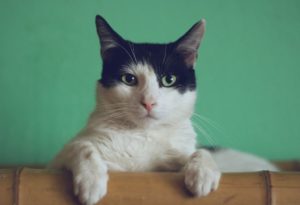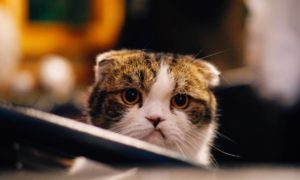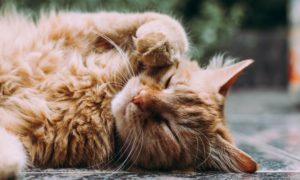Understanding Cat Body Language: Is Your Cat Mad at You?
Understanding Cat Body Language: Is Your Cat Mad at You?
You can learn a lot about your cat from their body language, just like you can with people. The first step to understand a cat’s body language is to focus on their physical cues. Whether they show it through different parts of their bodies, their meanings can vary based off of context. If you want to learn what your furry friend is trying to tell you, here are many signals you need to know about cat communication through different parts of their body.
What Your Cat’s Eyes Tell You

- Happy and Calm
When your cat is happy, their eyes will be at their typical size. You will notice that their eye movements are not frantic, and they aren’t as watchful. Additionally, dilated pupils can mean that they’re feeling friendly, or are feeling love and trust.
- Scared
Have you ever wondered why your cat’s eyes pupils look smaller than usual? This signal can mean that they are feeling aggressive, or fearful. Although, at times it means they are feeling excited.
- Other
When your cat is blinking slowly at you, it’s their way of saying “I love you.” Say it back to them by doing the same to share the love!
What Their Ears Tell You

- Happy and Calm
A happy and calm cat’s ears will be in its natural position. They won’t be angled, flat, and any unexpected ear movements will tend to be their response to sounds.
- Scared
When your cat is scared, you might notice that their ears are flattened or turned back. By doing this, they are trying to protect their ears, and it’s a good indicator that they’re afraid.
Cat Body Language Through Position and Paw-sture

- Happy and Calm
If your cat is laying down with their belly faced up, this is a sign that they are comfortable and feel safe. The belly is one of the most vulnerable areas of their body as it gives predators access to their vital organs. Sometimes cats will rub up against you; this is their way of marking their territory and showing affection.
- Scared
An arched back with standing fur can mean that they are feeling tense or afraid.
- Other
Have you ever noticed your cat scrunching their paws into fists like they’re kneading dough? This is commonly known as “making biscuits”, and this is their way of showing that they’re very content. They show this early on when they’re nursing as it increases milk flow.
What are They Tail-ing You?
- Happy and Calm
Tails are a great way to analyze cat body language. When your cat’s tail is up in the air as they walk, this is a sign of confidence and relaxation.
- Scared
A high tail in the air accompanied by tossing can mean that they are facing a threatening situation or are irritated. Additionally, A low, tucked tail can mean that they are scared and are trying to make themselves as small as possible.
Vocal Cues
- Happy and Calm
Purring is a sign of extreme happiness, pleasure, and relaxation; this is a big reason why they purr when you’re petting them.
- Scared
Depending on the situation, a growl, yowl, or hiss are usually signs of discomfort or threat.
- Other
Your cat might meow if they are hungry. Normally, cats don’t meow at one another, so it’s very likely they are trying to get your attention.
Signs of Distress to Watch Out For
A few signs that might indicate that your cat is sick, anxious, or in distress can include:
- Sudden mood changes
- Trembling
- No interest in playing or appearing lethargic
- Changes in appetite, eating, or drinking habits
- Rapid breathing and shortness of breath
- Hiding more than usual
- Excessive meowing
- Hissing or growling
If you notice any of these behaviours, or aren’t sure about what to do, contact your local veterinarian to decide if a consultation is needed.
Cat Body Language: Final Thoughts
These signals will help you understand your best fur-end’s feelings. By observing them, it will become easier to gauge their emotions and help them if something is wrong. If you have other animals, you can learn more about them through Pep & Pup’s blogs.
Image credits:
Photo by Ludemeula Fernandes on Unsplash
Photo by Michael Sum on Unsplash
Photo by Manja Vitolic on Unsplash


Leave a comment